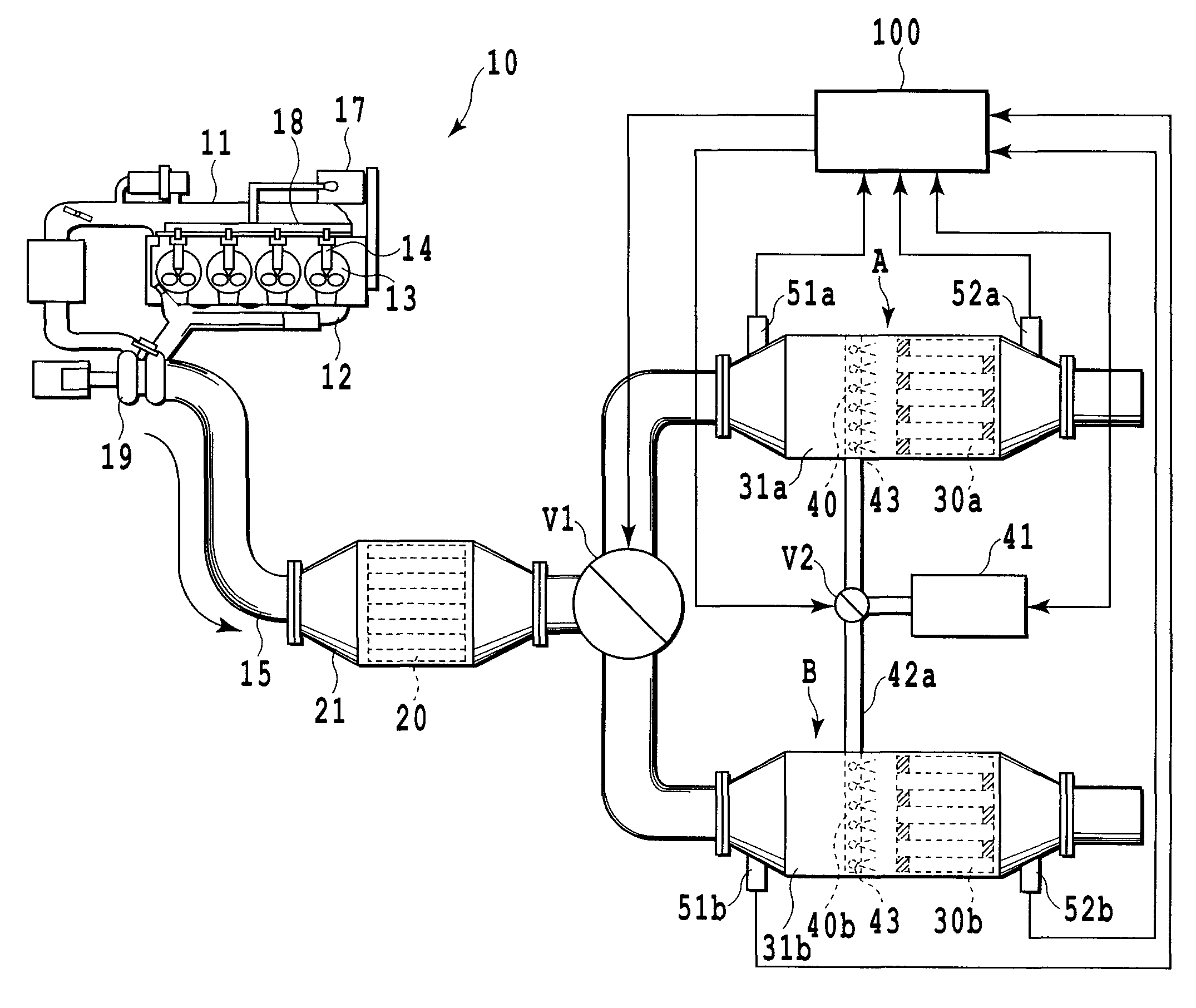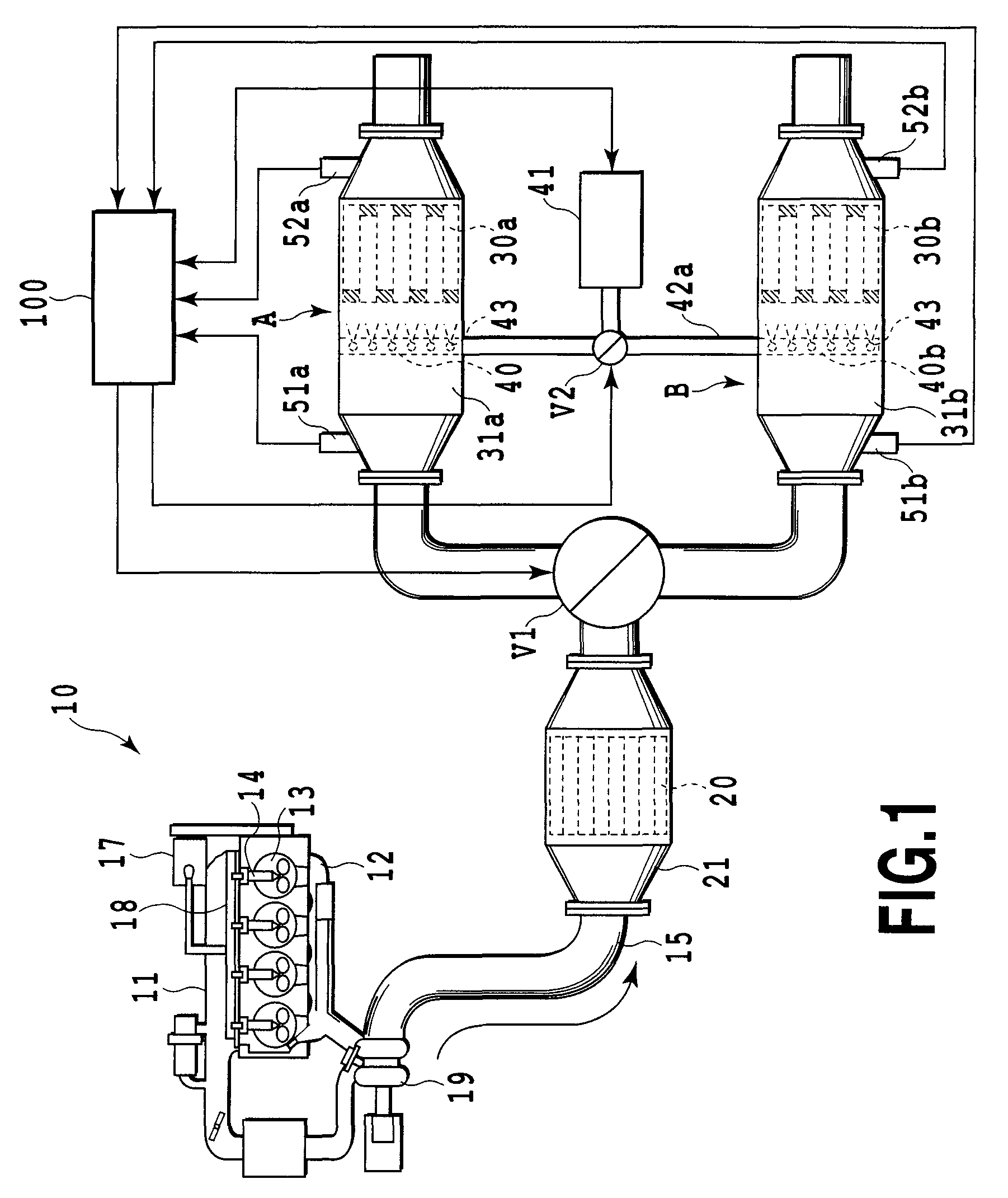Exhaust cleaner for internal combustion engine
a technology for exhaust cleaners and internal combustion engines, which is applied in the direction of exhaust treatment electric control, machines/engines, separation processes, etc., can solve the problems of difficult to completely oxidize and remove pm emitted from engines, air contamination, and deterioration of fuel consumption, so as to reduce the temperature
- Summary
- Abstract
- Description
- Claims
- Application Information
AI Technical Summary
Benefits of technology
Problems solved by technology
Method used
Image
Examples
first embodiment
[0057]FIG. 1 is a system diagram schematically showing an exhaust purifying system for an internal combustion engine in a first embodiment of the present invention. In the figure, numeral 10 denotes a compression ignition type internal combustion engine, i.e., a diesel engine, numeral 11 denotes an intake manifold communicated to intake ports, numeral 12 denotes an exhaust manifold communicated to exhaust ports and numeral 13 denotes a combustion chamber. In the present embodiment, fuel supplied to a high-pressure pump 17 from a fuel tank (not shown) is supplied under pressure to a common rail 18 by the high-pressure pump 17 and accumulated therein in a high-pressure state and the high-pressure fuel in the common rail 18 is directly injected and supplied into the combustion chamber 13 from a fuel injection valve 14. Exhaust gas from the diesel engine 1 flows from the exhaust manifold 12 to a turbocharger 19 and thereafter, flows into a exhaust passage 15 at the downstream side there...
second embodiment
[0104]Next, a second embodiment of the present invention will be explained with the accompanying drawings. FIG. 8 is a system diagram schematically showing an exhaust purifying system for an internal combustion engine in a second embodiment of the present invention. As illustrated, the second embodiment is provided with means for detecting a DPF floor temperature of each of DPFs 30a and 30b. That is, the DPFs 30a and 30b are respectively provided with temperature sensors 53a and 53b disposed therein and ECU 100 individually calculates the floor temperature of each of DPFs 30a and 30b based upon detection signals of the temperature sensors 53a and 53b. A temperature detecting section (in a case of a thermocouple, the tip) of each of the temperature sensors 53a and 53b is buried inside each of the DPFs 30a and 30b for detecting the floor temperature of each of DPFs 30a and 30b, but the temperature detecting section of each of the temperature sensors 53a and 53b may be disposed near th...
third embodiment
[0118]Next, the third embodiment of the present invention will be explained with the accompanying drawings. FIG. 11 is a system diagram schematically showing an exhaust purifying system for an internal combustion engine in the third embodiment of the present invention. As illustrated, the third embodiment is provided with means for detecting DPF floor temperature of each of DPFs 30a and 30b. That is, the DPFs 30a and 30b are respectively provided with temperature sensors 53a and 53b disposed therein and ECU 100 individually calculates the floor temperature of each of DPFs 30a and 30b based upon detection signals of the temperature sensors 53a and 53b. A temperature detecting section (in a case of a thermocouple, the tip) of each of the temperature sensors 53a and 53b is buried inside each of the DPFs 30a and 30b for detecting the floor temperature of each of DPFs 30a and 30b, but the temperature detecting section of each of the temperature sensors 53a and 53b may be disposed near th...
PUM
| Property | Measurement | Unit |
|---|---|---|
| length | aaaaa | aaaaa |
| diameter | aaaaa | aaaaa |
| temperature | aaaaa | aaaaa |
Abstract
Description
Claims
Application Information
 Login to View More
Login to View More - R&D
- Intellectual Property
- Life Sciences
- Materials
- Tech Scout
- Unparalleled Data Quality
- Higher Quality Content
- 60% Fewer Hallucinations
Browse by: Latest US Patents, China's latest patents, Technical Efficacy Thesaurus, Application Domain, Technology Topic, Popular Technical Reports.
© 2025 PatSnap. All rights reserved.Legal|Privacy policy|Modern Slavery Act Transparency Statement|Sitemap|About US| Contact US: help@patsnap.com



